Who remembers the photo of the pretty basket of fluffy chicks I posted at Easter time! Twelve weeks on and I thought I would write about our experience.
This was our first venture into the world of incubating eggs to add to our flock of hens although not the first in having chicks. Two years ago, we gave some fertile eggs to our top hen Betty when she became broody and she did all the work from then on: incubating the eggs, turning them, talking to them (did you know hens do that?) and raising the chicks that hatched. She did a grand job and it was fascinating to watch. Her two babies turned out to be both female and are now our most productive laying hens.
From a bio-security perspective, incubating eggs is the surest way to avoid introducing pests and diseases into a flock. We also fancied the experience and the learning that would come with it. We knew we could count on our neighbour to help us with any issues which, of course, all changed when lockdown and social distancing restrictions came into force half way through the process. We exchanged WhatsApp messages, with photos, instead!
Fertile eggs are readily available online and they can be sent in the post so if you are after a particular breed that you can’t find locally or want to buy from a particular breeder, then that is certainly an option. Hatching rates are generally lower that way because the eggs spend an extra day or two in transit in varying temperatures. I preferred to get hold of fertile eggs locally and that is what we did. We bought 12 Welsummer eggs from a local farm and we were able to see the parents; Welsummers lay dark brown eggs and are very colourful birds. We were also given some Skyline eggs and I was excited to try that breed because they lay blue eggs. We also got some Blackrock, Sussex Ranger, Speckledy and Pied Ranger. All in all another batch of 12 mixed eggs.
We wanted to increase our flock of laying hens by 3 or 4 new birds so we calculated that if we incubated 20 eggs, the chances were that we would achieve that: the odds of having hens and cockerels are about half, maybe a little higher towards cockerels so that would be 10 and 10 or thereabouts and as we were going half with our neighbour, who had lent us the incubators, we thought that was a good number to go for. In the end, 24 eggs went into two incubators which we set up in one of our spare bedrooms where the temperature and light levels could be as constant as possible; one machine had the purchased Welsummer batch and the other the gifted Skylines and other breeds.
One press of a button and the incubators started their job of nurturing the eggs in a way that mimics what a hen does when she sits on the eggs for 21 days. OK, it didn’t quite talk to the eggs like a hen does but it beeped each time it turned them. For 18 days, the eggs are kept at a constant temperature of 37.5°C, with a humidity level of 45% and are turned at regular intervals. After that, the incubator increases the humidity level to 60% to soften the egg shell and the eggs stop turning, at which point we removed the separators and prepared for hatching, which happens on Day 21.
Over the course of a couple of days or so, we witnessed the wonderfully magical process of eggs transforming into chicks. Hearing the chicks’ chirp from inside the shell was awe-inspiring; seeing them pip the shell to break out of it was very moving, as was meeting for the first time these strange miniature dinosaurs, all wet and unsteady on their feet, yet looking too big to have possibly hatched out of a small egg! No sooner had our first chick “unzipped” that another one was beginning to “pip” and this went on for around three days, a stressful time for us novices with lots of questions: why is this one taking so long? Should I help? Why isn’t this egg doing anything? Should we move the dry and active chicks out of the incubator?
We learnt that on Day 20, the yolk is completely absorbed into the chick, which makes it possible for them to go without food or water for 48 hours so we knew we could leave the chicks in the incubator for that long. We knew not to open the lid as that interferes with the temperature and humidity levels required for hatching. How we wished we could see what was going on behind that shell! The chick knows when it is ready to hatch and begins the process when it is fully developed. At that point, it completely fills the egg, apart from the air sack, and its beak is positioned to start pecking through the shell. We discovered that the chick has an “egg tooth” which begins to break through the membrane (this is called “pipping”) and as the chick’s lungs are fully functioning by this point, it breathes through the air sack. Bit by bit, we could see the chick break a line roughly in the middle of the egg, in circular motion, using its wing as a guide and its leg to move it. Eventually, the hole is big enough for the legs to squeeze through it and a final push parts the two halves of the egg shell and the chick is born.
Some chicks hatched quickly and some slowly. We preferred to let nature run its course but in the end, we helped two chicks out of their shells when after many hours of trying to hatch, they appeared stuck. By then, we had had to move the older ones, all dry and fluffed up after two days in the incubator, into the brooder where they could have water, food and heat. Opening the incubator is not at all advised as the drop in humidity can dry the membrane out and kill a chick but we had no choice and did so very carefully and with minimal disturbance. Yet, it is possible that for these two who seemed to struggle to hatch, our actions caused the shell to dry out and made it harder for them to “unzip” out of it. We gently pushed the shell apart for them. One was absolutely fine, very active straight away, found its feet and fluffed up very quickly. The other appeared to have curled feet and was finding it hard to stand. We didn’t hold much hope for him as we know when that happens, there is very little that can be done. A few hours later, his feet were completely normal and he was active, chirping away and possibly calling for the others as, by then, he was on his own in the incubator. When we were confident he was dry and warm, we reunited him with all the others in the brooder. After a while, the only way we could differentiate him from all his Welsummer siblings was with the little bit of egg shell stuck on his head and no longer by his feet or his awkward gait! That was a real lesson for me about not giving up on a new chick just because they need extra help initially.
In the end, eight chicks hatched out of twelve eggs in each batch, which overall is a poor hatch rate. Ten out of twelve is the average. Out of the eight that didn’t hatch, six had not developed and two were dead with their shells still intact. We ended up with sixteen chicks altogether: 8 Welsummer, 1 Pied Ranger, 1 Speckledy, 5 Skyline and 1 of unknown breed. A beautiful mixture of brown, yellow and black little balls of fluff, darting about, drinking and eating, scratching and pecking the ground and with wing feathers already beginning to appear at a few days old.
They outgrew their brooder pen in the spare room in less than two weeks, at which point we moved them into a bigger pen in the garage with the brooder pad still plugged in. We aimed to have them free to roam during the day by about 5 weeks old and we did this in stages. First, unless the weather was cold and wet, we moved the pen out onto the lawn for them during the day. By then, they were feathering up nicely and requiring heat from the brooder only at night. When it became too difficult to pick them up and put them all in a box to carry them from garage to lawn, we used a dog crate. When they out grew that, we stopped using the pen in the garage and introduced them to their new hen house, a pigsty which we had just finished converting into a permanent chicken coop to accommodate our growing flock. For now, it was going to be our chicks’ house at night. We set up a spare chicken coop and run nearby and we ushered them into there during the day after letting them out each morning. They learnt the ropes very quickly and when it began to become difficult to contain them in the run, we began to let them roam free whilst supervised. We started with about half an hour before they went to bed and gradually increased this till we knew they were safe enough from our cat Oscar, the other hens and of course birds of prey and other dangers around. By the middle of May, they were free-ranging and quickly expanding the range of their explorations, which prompted an emergency purchase of several rolls of chicken wire because they could get through gaps our adult hens can’t, like the veg patch! And sixteen chicks can peck a row of lettuce bare very quickly!!!
At this point we introduced medicated growers’ pellets into their diet to give them some protection against coccidiosis which they can pick up from the ground and can be fatal. They were also wormed when we started to take them outside onto the lawn. They grew in confidence to be bald enough to defend themselves against an adult hen that came too close and Oscar gives them a wide berth whenever he can. They learnt to find shelter under bushes when they needed to and I spent a lot of time with them to tame them a little so that I could catch them if I needed to check something. Some were naturally more friendly than others, two made it a habit to climb on my leg whenever I sat down!
From then on, came the fascinating task of sexing them and it was not at all as straight forward as we were reading or hearing. It was relatively easier with the Welsummers but with the others, it was much harder and we couldn’t decide. We now know why it was so hard: out of sixteen chicks, we had three hens and thirteen cockerels and we didn’t expect that. I had been confident that the three hens were hens several weeks before but I was looking for more hens in the thirteen cockerels and was trying to see differences that weren’t really there: a wattle and comb a little less red in some, chest a little less brown on the Welsummers… until it dawned on me what we had. Then it was obvious and the crowing and fighting enabled us to confirm our hunches. The odds are slightly higher for cockerels but we had a poor ratio here!!
It would have been nice to have more choice with the hens, although I am very happy with our one Welsummer, one Skyline and one the breed of which we are unsure. Extra hens would have also given us the opportunity to sell some, which would have helped recoup some of the money spent on feed. The agreement with our neighbour was that he would take the cockerels to finish off as meat. We have kept one beautiful Welsummer chap (think of the cockerel on the Kellogs Cornflakes packet!) to keep in our flock as having a male does provide extra protection and gives us the chance to have fertile eggs for future incubating or to sell. His cockledoodledoos in the early morning are not too much of a bother at present as he is still finding his voice! His twelve mates have now gone up the hill to join the neighbour’s flock and our 12-week old chicks are settling into our already established little flock. They hang around largely together, moving as a group of four, and they do look a little lost in the new hen house. We will be introducing the other hens into it at some point and we will do so when we no longer feed them medicated pellets, which laying hens cannot have.
In the meantime, we look forward to our three young hens laying their first eggs in about six to eight weeks’ time, when the older ones will begin to decrease their production as the days become much shorter. Will we have blue eggs to add to our egg boxes?


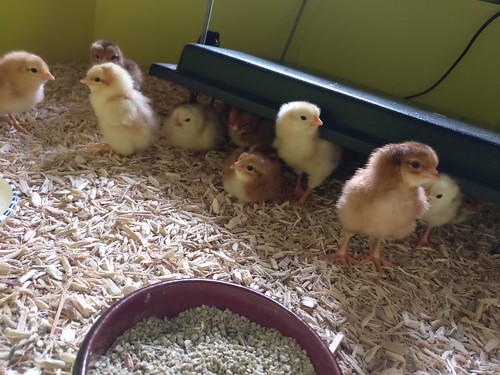

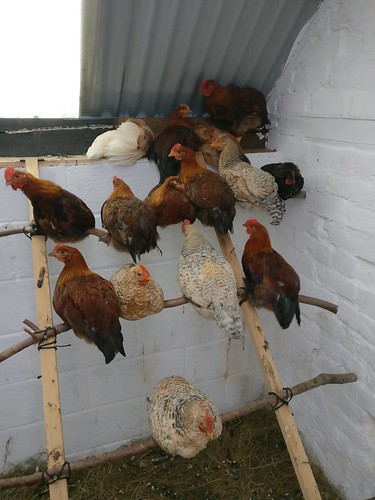
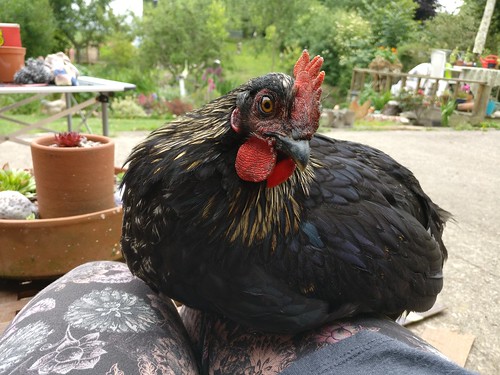

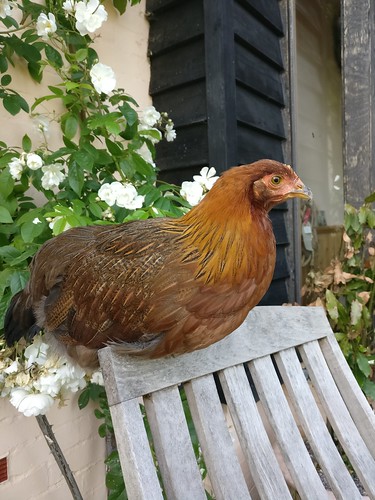

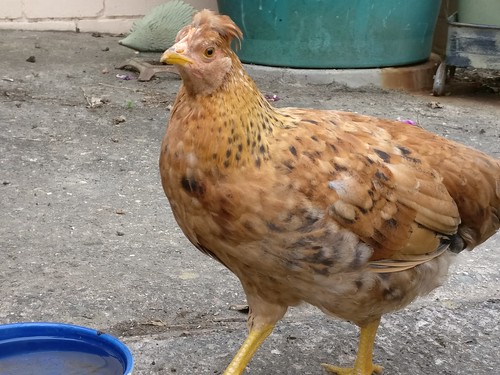
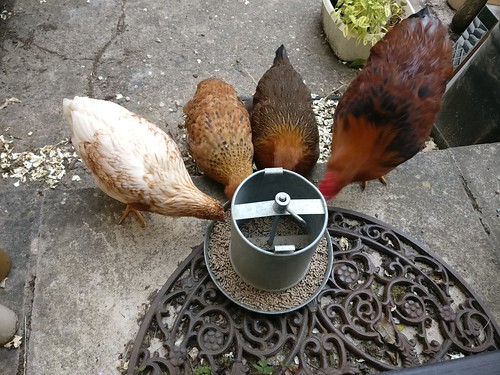
So fun and informative to hear your experience! Looking forward to raising chicks soon too
Posted on By Eilene
Enjoy your experience of raising chicks. Two of these chicks are still with us, laying beautiful eggs for us. One of them has even raised her own chicks!
Posted on By Maryline